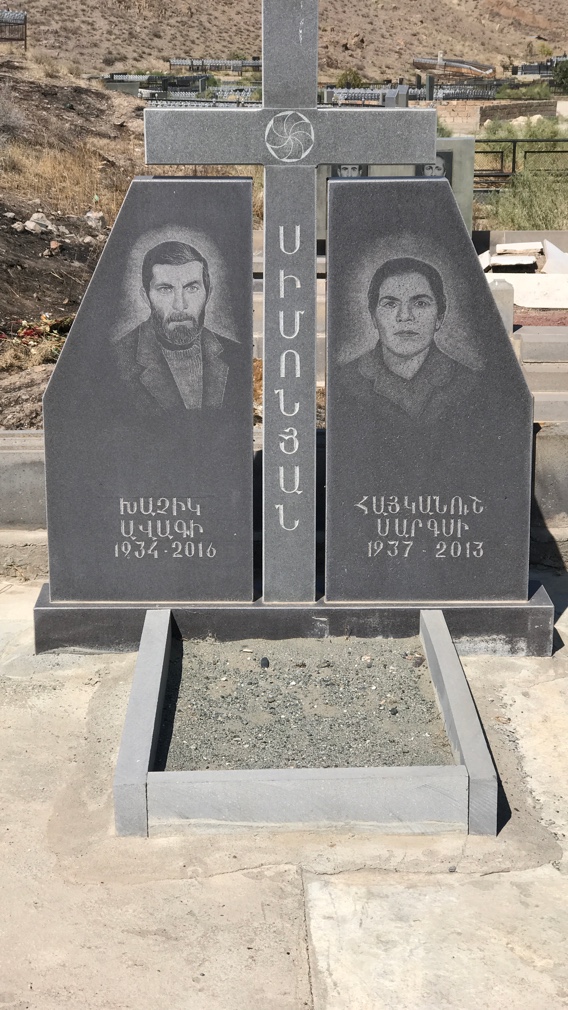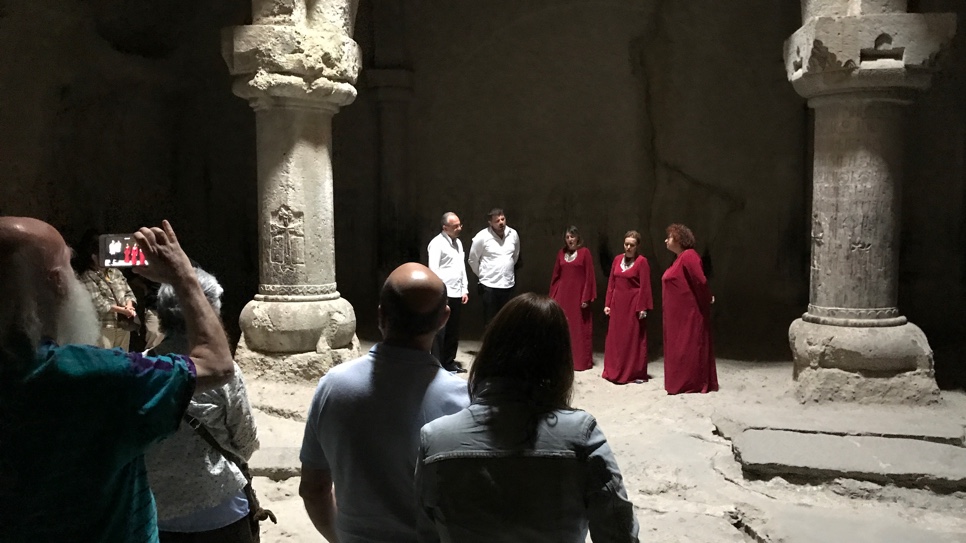Sunday, September 22
We were picked up at the Tbilisi train station by our Georgia driver, who drove us to the border. Along the way, he and another driver were pulled over, presumably for speeding. He said later, as we parted, that he had to pay 150 lari, the same amount coincidentally that I was giving him as a tip. Sigh.
We walked through Georgia customs, down the road a ways, and then through Armenia customs. On the other side was our Armenian guide Armen. We got in the car and started driving through beautiful mountain scenery. The roads were really rough, and we had to go slow. As we drove, we saw a couple large sluices that take seasonal rivers over the tops of railroad tracks so that the tracks effectively run behind waterfalls.
Armen spoke at a whisper, most of the time. Neither of us could hear him. But as usual most of it is on Wikipedia. Although it was interesting to hear the opposite point of view from day before yesterday, on everything. And he spoke much better English than either of the other guides, to the extent that we could actually joke with him.
Armen also mentioned the bulldozing of the graves south of Baku.
The principal contradiction in tour guides of all kinds, is that they offer you no help at all in planning itineraries. When you contact them, you say: I want to see this and this and this and I have seven days.
What they ought to say is: you are stupid. If you try to see all those things, you will live in a car.
What they do say is “OK!”
And you spend all day in a car, drive past fascinating and beautiful things or fascinating and ugly things, and you can’t get the drivers to stop because they grew up thinking that intourist was the best travel agency of all, and checking off destinations in the itinerary is not the important thing, it is the only thing.
Maybe the market demands this. Maybe the majority idea of travel is to put a check in the box next to every world heritage site on UNESCO’s list. I do that too, but to me a WHS is a place to go watch little kids wrestle on the lawn and young lovers spooning on 1200 year old walls and ridiculous Koreans making ridiculous selfies, where Koreans means humans.
When you go to a country your choice is: miss nearly everything, or miss everything.
When we arrived at Haghpat, the first monastery, the first thing, of course, was lunch in their large tourist restaurant.
After lunch, we explored the monastery. Several diagrams with crosses carved into the side illustrated pilgrimages which had been made to this monastery long ago. At some point, they stopped doing that. Instead of a large church space, the monasteries we saw had a small space, with a larger room called a gavit just outside it, that you entered through. Frescoes were common inside these stone buildings.

Most monasteries had a stone honoring the donors, showing them holding the building. Many had sundials in the outer walls. Most had many khachkars, or “cross stones”, elaborately sculpted designs on a large stone, featuring a cross. Armen calls the sun designs swastikas.

It was quite a distance to Haghartsin, the second monastery. By the time we were finished there, the sun had set, and there wasn’t really time to see Lake Sevan.
We went to our hotel in Yerevan, and then set out to find some dinner. It was a bit late, and places were closing, but we found a local chain restaurant from which a tour bus worth of people was emerging, waited a few minutes, and sat down. Their menu was full of pictures, with English captions, and it was easy to find interesting things to order. Sorrel soup, and lamb lungs and heart as a stew, both good. You can only get lamb lungs as dog treats in the U.S. The FDA forbids them because they might be contaminated with stomach contents. It is regarded as a given, in America, that food will be produced carelessly and ignorantly, and that anything which cannot be produced by an overworked and inexperienced worker must be banned.
“I aimed for the public’s heart and by accident hit it in the stomach.”
— Upton Sinclair, on the reaction to The Jungle
Monday, September 23
We headed south out of Yerevan, and saw the dominating presence of Mt. Ararat, long supposed to be where Noah’s Ark ended up, a mountain sacred to all Armenians. Too bad that current borders put it in Turkey. It’s actually quite close to where Turkey, Armenia, Nakhchivan (an exclave of Azerbaijan), and Iran all meet.
The first monastery was Khor Virap, located on a little rise in the agricultural area at the base of Mt. Ararat. It has a chapel that is not oriented East-West, because it is built on the site of the pit prison in which Gregory the Illuminator was held as the result of complicated soap opera politics for some fourteen years. When he emerged, he persuaded King Tiridates III to adopt Christianity and bring the whole nation of Armenia along with him, making Armenia the first Christian nation in the world, and a founding father of murderous intolerance. They celebrated by killing a thousand Hindus who had lived there for nearly half a millennium, and destroying their temples.
Modern Christians have such a weird idea of what “conversion” means.
As you drive south, you pass along a large berm similar to the one on Highway 23 past Lake Okefenokee and many similar reservoirs around the world. This one is to protect cars from shooting, coming from the exclave.
The second monastery was Noravank Monastery, in a beautiful red-rock canyon. It features a three-story church; one accesses the top story by climbing up a scary staircase jutting out from the wall, with no handrail.

We descended the canyon, and had delicious barbecued chicken at a little tourist restaurant, mostly outdoors. Then we drove a short distance to Areni Cave 1, home of the oldest shoe ever discovered. (We saw the shoe the next day at the History museum). It also contained the earliest known winery, and also the oldest Old World brain tissue, attached to a skull. Today I learned the archaeological term for batshit: “Zoogenic humus”.
Then, back to Yerevan. We bought Mulberry molasses from a roadside seller on the way. Mulberry anything is an easy sell.
Dinner was at another restaurant with a picture menu, this time in a large bustling one with live music. We were sitting directly above the band. Many of the songs were a bit corny, including a cover of “Get Lucky”, but the musicianship was great. The experience was $21 for both of us and the music, too.
Tuesday, September 24
A magical sound moment began the day. We dropped off post cards at a barely open post office at a desk at the edge of a giant concrete room. There was one person on duty, and none of the other shops that usually occupy the bustling mall were open. We handed her the cards. As we walked away across the room, we heard the rhythm of the cancellation of one postcard after another resonantly booming across the vacant mall.
Less magical: Astroturf topiary, outside the coffee shop “Eat&Fit”. Our guide and the driver met us there.
For today’s day trip, we headed southeast out of Yerevan toward the Geghard monastery. On the way out of town, our guide told us that Armenians raise cows, and Yazidi raise sheep, and the people selling sheep from the side of the road were Yazidi, marketing them for ceremonies. Yazidis are most lately in the news as the victims of genocide conducted by ISIS in Iraq. It wasn’t the first one.
Geghard is in a striking setting in the mountains, built against a cliff. Some of the patterns carved around the doors, and some of the dome ceilings, reminded us of patterns we’d seen in Morocco and Spain. The guide insisted they weren’t inspired by Islamic art, that it was coincidental, and pretty. OK, whatever. We heard a chorus singing in a big round resonant room, and bought the CD.

From there, a short drive led us to Garni, a pagan temple. It actually seemed a bit like the Lincoln Memorial or something, with columns all around it. It overlooks a stupendous canyon.
All of these buildings have been demolished several times over by attacks and earthquakes, and reconstructed to the best of the ability of the people at the time. The “dragon stones” have survived. They evolved from prehistoric phalluses, and later became crosses. Conversion is bloody, but also, incomplete.
We headed back through Yerevan to the Echmiadzin Cathedral on the north side of town. It is in a huge complex, but it was completely enclosed in scaffolding and completely closed except for a courtyard in front. It probably wasn’t worth the trouble to drive out there, except for the shop where one can purchase post cards of Armenian historical types.
But a short distance away was the Zvartnots ruins, a round church which had been buried for a millennium. It was rediscovered, exposed, and a museum built. What remained or had been set back up reminded one a bit of Stonehenge.
Driving back, we passed the American Embassy. There were posters all around the outside, and none show Trump. I think I looked at all of them and did not see the President.
“If you’re lucky, he doesn’t know where Armenia is,” I said to Armen. The government paid last year to paint the houses pink on the main road, for the 2800-year anniversary of Yerevan.
Afterward we headed to the history museum in town, and walked around it until it closed. There we saw the shoe from the cave. There was a room devoted to scenes of the Armenian genocide. Everything is devoted to that. They feel so cheated by the Holocaust, like the mass murderer arrested on the 10th of September, 2001, who told the reporter that his crime ought to be good for at least a week of headlines.
I need to mention somewhere: “As I told you” is a common phrase among all the tour guides we’ve encountered, and it’s super annoying since they chatter all day and make no effort to actually teach. And if we don’t remember some Ethiopian bee-eater or Azerbaijani prince, the implication is that we have flunked. I’d like to think I am paying attention. But they’ve been at this — making history, I mean — for thousands of years, in every corner of the world.
There was a demonstration outside a government building, near the museum. “Paid demonstrators,” said our guide. “It happens everywhere.”
“So does that explanation,” I said. They were possibly supporters of the recently ousted president. Armen lost interest in explaining it to us and I lost interest in straining to hear him.
We walked through town, down a generic diagonal modern street which could be a main shopping street anywhere in the world, and then had dinner at a small restaurant, at Armen’s recommendation. “Our Village”, it was called, in English. It is set up for tour groups. I think Armen doesn’t know any other kind. Cold bread, high prices. But it was all we could get into at 1845 on Tuesday. Not sure why the restaurants were so crowded just then.
We went back to the hotel and prepared to be picked up at 3:30am for our flight to Bucharest.